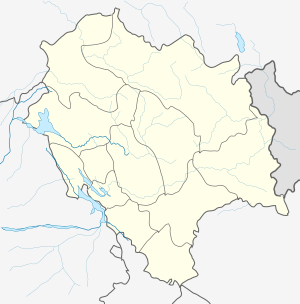Kibber
Kibber also Kyibar is a village high in the Spiti Valley in the Himalayas at 4270 metres or 14,200 ft in Himachal Pradesh in northern India. It contains a monastery and the Kibber Wildlife Sanctuary. Kibber lies in a narrow valley on the summit of a limestone rock. It is located 20 kilometres from Kaza and a bus service connects them in the milder summer months. Agriculture forms the backbone of the local economy and lush green fields are abundant.[1] Villagers count on the 3 day traditional trade route over Parang La to Ladakh to barter their horses for yaks or to sell for cash.[1]
Kibber | |
|---|---|
Village | |
Kibber village in winter | |
 Kibber Location in Himachal Pradesh, India  Kibber Kibber (India) | |
| Coordinates: 32.331667°N 78.008889°E | |
| Country | |
| State | Himachal Pradesh |
| District | Lahul and Spiti |
| Elevation | 4,270 m (14,010 ft) |
| Population (2011) | |
| • Total | 366 |
| Languages | |
| • Official | Hindi and the indigenous languages of the Ladakhi peoples of Indo-Aryan and Tibetan descent. |
| Time zone | UTC+5:30 (IST) |
| Vehicle registration | HP- |
| Climate | Dfc |
History
The village has around 80 houses, unique, given that they are made of stone instead of mud or adobe brick used extensively elsewhere in the Spiti valley.[1] Kibber has a civil dispensary, a high school, a post office, a telegraph office and a community TV set in the village.[1] Kibber Monastery was founded by Serkang Rimpochhe of Tabo.
Demographics
Kibber Khas is a small village located in Spiti of Lahul and Spiti district, Himachal Pradesh with total 77 families residing. The Kibber Khas village has population of 366 of which 187 are males while 179 are females as per Population Census 2011.
In Kibber Khas village population of children with age 0-6 is 36 which makes up 9.84% of total population of village. Average Sex Ratio of Kibber Khas village is 957 which is lower than Himachal Pradesh state average of 972. Child Sex Ratio for the Kibber Khas as per census is 565, lower than Himachal Pradesh average of 909. Kibber Khas village has lower literacy rate compared to Himachal Pradesh. In 2011, literacy rate of Kibber Khas village was 72.73% compared to 82.80% of Himachal Pradesh. In Kibber Khas Male literacy stands at 82.93% while female literacy rate was 62.65%.[2]
Kibber Wildlife Sanctuary

The Kibber Wildlife Sanctuary was established in 1992, which spans over an area of 2,220.12 km2 of land.[3] The elevation range of this sanctuary is 3,600-6,700 m above mean sea level. The vegetation here is sparse and have high medicinal properties. This sanctuary has been extensively surveyed by C.P. Kala for distribution of plants and their indigenous uses as established by the amchis - the practitioners of Tibetan medical systems. Eight rare and endangered medicinal plant species have been discovered by C.P. Kala from this sanctuary. Aconitum rotundifolium, Arnebia euchroma, Ephedra gerardiana, Gentiana kurroo and Dactylorhiza hatagirea are such threatened but medicinally important plants occur in this sanctuary.[4][5]
Up to 30 snow leopard has been found by wildlife wing of forest department of Himachal Pradesh.[6][7]
References
- "The Tibetan Buddhist Monasteries of the Spiti Valley".
- "India 2011 census". Retrieved 7 September 2015.
- http://hpforest.nic.in/files/KibberWildLifeSanctuary_A1b.pdf
- Kala, C.P. 2005. Indigenous uses, population density, and conservation of threatened medicinal plants in protected areas of Indian Himalayas. Conservation Biology, 19 (2): 368-378.
- Kala, C.P. 2005. Health tradition of Buddhist community, and role of amchis in trans-Himalayan region of India. Current Science, 89 (8): 1331-1338.
- "Up to 30 snow leopards in Kibber wildlife sanctuary of Spiti". Times of India.
- "Spiti Snow leopard trail". Raacho Trekkers.